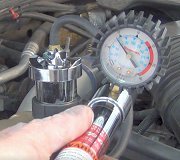Read and understand instructions and follow them carefully. Never turn the engine counterclockwise unless instructed and not more than specified. When turning the engine to get TDC for first cylinder, always turn the engine clockwise. A loose timing chain can jump time if it is turned counterclockwise.
WATER PUMP
Removal
1. Drain coolant from radiator and cylinder block. Remove water pump drain plug. See Fig. 10. Support engine and remove right side engine mount nuts, mount and bracket. Remove drive belts and idler pulley bracket. Remove timing chain tensioner cover and water pump cover. See Fig. 11.
2. Push tension sleeve back to relieve chain tension. Push stopper pin to hold sleeve in retracted position. See Fig. 12. Remove timing chain tensioner assembly. Secure a gap between timing chain and water pump by rotating crankshaft pulley 20 degrees counterclockwise. Remove 3 water pump mounting bolts. See Fig. 13.
3. Install two 8-mm bolts in the opposing water pump bolts holes. See
Fig. 14. Tighten bolts evenly until they contact rear timing chain case. Tighten bolts 1/2 turn at a time until water pump separates from rear timing chain case. Remove water pump. When removing water pump, do not allow water pump gear to hit timing chain.
Installation
CAUTION:
Ensure "O" rings are not damaged when installing water pump.
1. Apply engine oil to first "O" ring and coolant to the second "O" ring. See Fig. 15. Using a suitable tool, move timing chain to one side and install water pump. Tighten water pump bolts to specification.
2. Clean old liquid gasket from water pump and tensioner covers. Apply liquid gasket to water pump and tensioner covers. Return crankshaft pulley to original position, by rotating it 20 degrees clockwise. Install timing chain tensioner and remove stopper pin. Tighten timing chain tensioner bolts to specification.
3. Install coolant, block and drain plugs. Refill cooling system to proper
specification.
4. After installing water pump and tensioner covers, race the engine at about 3000 RPM under no load to purge air from tensioner high pressure chamber. Engine may make noise, this is normal and indicates that there is air in tensioner high pressure chamber.
Images (Click to make bigger)
Tuesday, January 1st, 2013 AT 2:58 PM









